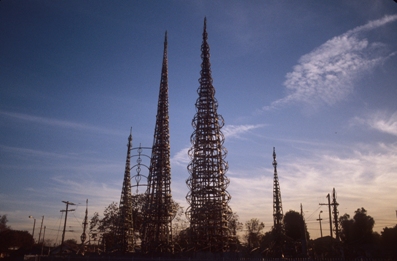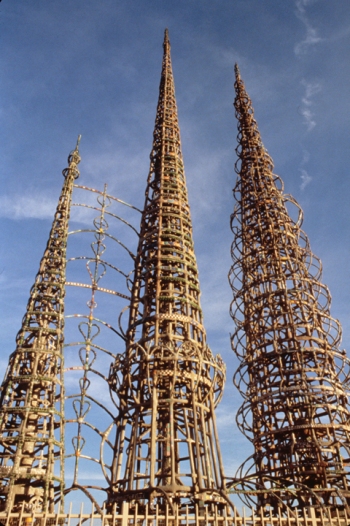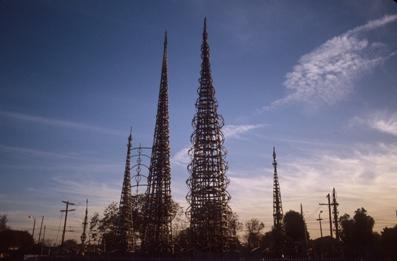In late 2010 LACMA partnered with the City of Los Angeles’s Department of Cultural Affairs to address the long-term preservation of the Watts Towers. To learn more about this project, I spoke with the two people at LACMA who are spearheading the project—Brooke Davis Anderson, Deputy Director of Curatorial Planning, and Mark Gilberg, the Suzanne D. Booth and David G. Booth Conservation Center Director.
UPDATE: We are pleased to announce that the James Irvine Foundation has awarded a $500,000 grant toward the preservation of the Watts Towers. The Los Angeles Times has the story.

Photo: Jo Farb Hernández, courtesy of SPACES—Saving and Preserving Arts and Cultural Environments
Brooke Davis Anderson: LACMA became involved with Watts Towers and the cultural activities on 107th street when the city approached us about our expertise in conservation, fundraising, and marketing to build an audience for Watts Towers. The city has been the caretaker of the Watts Towers for some time now (it’s actually still owned by the state), but it’s a project that’s so comprehensive that it really needs as many partners as possible so we can be successful in preserving this monument for Los Angeles.
You’re fairly new to LACMA, and new to Los Angeles. What’s your experience been in getting to know the community members and organizations in Watts?
BDA: I’m new to Los Angeles, I’m new to LACMA, but I’m not new at all to art like Watts Towers or artists like Simon Rodia. For the last twenty-five years I’ve been specializing in self-taught artists and their work. So I knew of Watts Towers and visited the Watts Towers long before I, frankly, knew of LACMA. That was my destination when I came to L.A. I love it down on 107th street. This is perhaps one of the most important works of art produced in Los Angeles and one of the most important examples of vernacular architecture in America, and it’s certainly up there with Nek Chand Rock Garden in India, the Palais Idéal in France, and a few other very stellar examples of this kind of artistic experience. I find it a complete privilege to be collaborating on the towers.
Also, the cultural experience and our partners, the Watts Towers Arts Center and the Watts House Project, are not unfamiliar to LACMA, so we already have a foundation from which we plan to build richer connections and deeper ties with both of those organizations as well as the neighbors who live there, in addition to collaborating strongly with the city. That is my responsibility, to make sure all lines of communication are open and clear between all the various partners. Whereas Mark is really charged with the very awesome task of coming up with a conservation plan.
Yes, the bulk of what we’re tasked with doing in this first year with Watts Towers is really conservation-oriented. Mark, can you tell me a little about what our goals are, or what we’re trying to achieve in the next twelve months?
Mark Gilberg: Essentially the city sub-contracted us to revise the conservation handbook and to undertake the day-to-day maintenance of the towers. I believe the last edition of the handbook was published in 1998, and it requires extensive revision. The city also asked us to undertake periodic site inspections and to undertake any restorations and minor repairs to the towers that may be needed.
You both took me to the towers last month, and the thing that I got out of that tour and talking with others is that the artwork and the community are indelibly intertwined. To talk about the community is to talk about the towers, and vice versa.
BDA: I think that’s because there is still a direct link between the maker and the community. We still have members of the community who will tell you that when they were children they would climb the towers (even though we wouldn’t allow this now) and treat it as the local jungle gym. Older members of the community remember being asked by Simon Rodia to collect broken bits of glass and miscellany, and they were paid for that activity.
For the many different constituencies down there it tends to be a meeting place. That for me illustrates the power of art, creating a neutral space where we can come together and negotiate whatever is going on with our community socially, culturally, economically, politically, etc.

Photo: Jo Farb Hernández, courtesy of SPACES—Saving and Preserving Arts and Cultural Environments
They are really kind of awe-inspiring—like a beacon or a campanile within the city.
BDA: One of my favorite stories from the recent conference at UCLA about the Watts Towers was when the artist Betye Saar said that as a little girl she lived in Watts with her grandmother for a year. So she was in Watts as a kind of a temporary resident. Walking to school and back, she would always see the towers “over there,” so she would always try to walk home in a different way to find it—but she never could. She never got to the towers until she was a mother herself, taking her two daughters (the artists Alison and Lezley Saar) to see them. But that whole idea of them always being there, always offering a moment of discovery for people, leads to so many folks taking ownership of the towers.
Speaking of the towers as a source of inspiration for other artists, James Turrell has said his memories of seeing Watts Towers taught him that a single artwork could be a decades-long project.
BDA: One thing I’m interested in as we move forward promoting Simon Rodia and the Watts Towers is really trying to honor the seriousness of the object and Rodia as a working artist—not an idiosyncratic person, not a solitary person, but working at a craft in the same manner that John Baldessari or Betye Saar or James Turrell or any other practicing artist engages. Simon Rodia created something that is begging for interaction with community, yearning for acknowledgement from neighbors and the neighborhood, and really wanting to stand out in celebration of place and creativity and art-making.
Balancing the respect for what the artist intended is something that in conservation, Mark, you’re attuned to on every project you do, no?
MG: The artist’s intent is something that must always be taken into consideration when undertaking any conservation project. In this case it’s extremely difficult to define what the artist’s intent was. It wasn’t built in one year; it was built over a very long period of time. Rodia changed his mind along the way and made alterations. In fact, he was the first restorer and was constantly making repairs as he was building the towers.
Beyond inventorying the current records, how to you begin to assess the conservation needs for a project this huge, and how do you then go forward?
MG: You have to have some point of reference. One of the tasks we’re considering is redoing the original photographic record begun in 1986 by Marvin Rand and completed in 1992. The 4x4-foot grid system used for this photography formed the basis for all subsequent conservation work and photographic documentation of the towers. It’s the bible for this entire conservation project. Redoing this photographic survey will give us the means to determine exactly how much original material has been lost over the years and to some extent how much restoration has taken place.
My goal this year is to really collect and synthesize all the background information there is on the towers and organize it into a format that is easily assessable and that can be used to make intelligent, informed decisions regarding its future treatment.
Learn more about the Watts Towers, including a newly restored 1957 short film about the towers and Simon Rodia.
Scott Tennent



